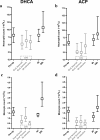Cerebral ischemia initiates an immediate innate immune response in neonates during cardiac surgery
- PMID: 23390999
- PMCID: PMC3599234
- DOI: 10.1186/1742-2094-10-24
Cerebral ischemia initiates an immediate innate immune response in neonates during cardiac surgery
Abstract
Background: A robust inflammatory response occurs in the hours and days following cerebral ischemia. However, little is known about the immediate innate immune response in the first minutes after an ischemic insult in humans. We utilized the use of circulatory arrest during cardiac surgery to assess this.
Methods: Twelve neonates diagnosed with an aortic arch obstruction underwent cardiac surgery with cardiopulmonary bypass and approximately 30 minutes of deep hypothermic circulatory arrest (DHCA, representing cerebral ischemia). Blood samples were drawn from the vena cava superior immediately after DHCA and at various other time points from preoperatively to 24 hours after surgery. The innate immune response was assessed by neutrophil and monocyte count and phenotype using FACS, and concentrations of cytokines IL-1β, IL-6, IL-8, IL-10, TNFα, sVCAM-1 and MCP-1 were assessed using multiplex immunoassay. Results were compared to a simultaneously drawn sample from the arterial cannula. Twelve other neonates were randomly allocated to undergo the same procedure but with continuous antegrade cerebral perfusion (ACP).
Results: Immediately after cerebral ischemia (DHCA), neutrophil and monocyte counts were higher in venous blood than arterial (P = 0.03 and P = 0.02 respectively). The phenotypes of these cells showed an activated state (both P <0.01). Most striking was the increase in the 'non-classical' monocyte subpopulations (CD16(intermediate); arterial 6.6% vs. venous 14%; CD16+ 13% vs. 22%, both P <0.01). Also, higher IL-6 and lower sVCAM-1 concentrations were found in venous blood (both P = 0.03). In contrast, in the ACP group, all inflammatory parameters remained stable.
Conclusions: In neonates, approximately 30 minutes of cerebral ischemia during deep hypothermia elicits an immediate innate immune response, especially of the monocyte compartment. This phenomenon may hold important clues for the understanding of the inflammatory response to stroke and its potentially detrimental consequences.
Trial registration: ClinicalTrial.gov: NCT01032876.
Figures






References
Publication types
MeSH terms
Associated data
LinkOut - more resources
Full Text Sources
Other Literature Sources
Medical
Miscellaneous

